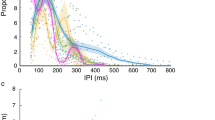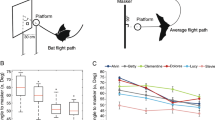Abstract
In bats1 and technological sonars2, the gain of the receiver is progressively increased with time after the transmission of a signal to compensate for acoustic propagation loss. The current understanding of dolphin echolocation indicates that automatic gain control is not a part of their sonar system3. In order to test this understanding, we have performed field measurements of free-ranging echolocating dolphins. Here we show that dolphins do possess an automatic gain control mechanism, but that it is implemented in the transmission phase rather than the receiving phase of a sonar cycle. We find that the amplitude of the dolphins' echolocation signals are highly range dependent; this amplitude increases with increasing target range, R, in a 20 log(R) fashion to compensate for propagation loss. If the echolocation target is a fish school with many sound scatterers, the echoes from the school will remain nearly constant4 with range as the dolphin closes in on it. This characteristic has the same effect as time-varying gain in bats and technological sonar when considered from a sonar system perspective.
This is a preview of subscription content, access via your institution
Access options
Subscribe to this journal
Receive 51 print issues and online access
$199.00 per year
only $3.90 per issue
Buy this article
- Purchase on Springer Link
- Instant access to full article PDF
Prices may be subject to local taxes which are calculated during checkout


Similar content being viewed by others
References
Simmons, J. A., Moffat, A. J. M. & Masters, W. M. Sonar gain control and echo detection thresholds in the echolocating bat, Eptesicus fuscus. J. Acoust. Soc. Am. 91, 1150–1163 (1992)
Medwin, H. & Clay, C. S. Fundamentals of Acoustical Oceanography (Academic, San Diego, 1998)
Au, W. W. L. & Herzing, D. L. Echolocation signals of wild Atlantic spotted dolphin (Stenella frontalis). J. Acoust. Soc. Am. 113, 598–604 (2003)
Urick, R. J. Principles of Underwater Sound (McGraw Hill, New York, 1983)
Henson, O. W. Jr The activity and function of the middle ear muscles in echolocating bats. J. Physiol. (Lond.) 180, 871–887 (1965)
Suga, N. & Jen, P. H. S. Peripheral control of acoustic signals in the auditory system of echolocating bats. J. Exp. Biol. 62, 277–331 (1975)
Au, W. W. L. The Sonar of Dolphins (Springer, New York, 1993)
Au, W. W. L., Ford, J. K. B. & Allman, K. A. Echolocation signals of foraging killer whales (Orcinus orca). J. Acoust. Soc. Am. 111, 2343–2344 (2002)
Rasmussen, M. H., Miller, L. A. & Au, W. W. L. Source levels of clicks from free-ranging white beaked dolphins (Lagenorhynchus albirostris Gray 1846) recorded in Icelandic waters. J. Acoust. Soc. Am. 111, 1122–1125 (2002)
Ketten, D. R. in Hearing by Whales and Dolphins (eds Au, W. W. L., Popper, A. N. & Fay, R. R.) 43–108 (Springer, New York, 2000)
Heithaus, M. R. & Dill, L. M. in Encyclopedia of Marine Mammals (eds Perrin, W. F., Wursig, B. & Thewissen, J. G. M.) 411–422 (Academic, San Diego, 2002)
Evans, W. W. & Powell, B. A. in Animal Sonar Systems: Biology and Bionics (ed. Busnel, R. G.) 363–382 (Laboratoire de Physiologie Acoustique, Jouy-en-Josas, 1967)
Morozov, B. P., Akapiam, A. E., Burdin, V., Zaitseva, K. A. & Solovkh, Y. A. Tracking frequency of the location signals of dolphins as a function of distance to the target. Biofizika 17, 139–145 (1972)
Cranford, T. in Animal Sonar: Processes and Performance (eds Nachtigall, P. E. & Moore, P. W. B.) 67–77 (Plenum, New York, 1988)
Cranford, T. in Hearing by Whales and Dolphins (eds Au, W. W. L., Popper, A. N. & Fay, R. R.) 109–155 (Springer, New York, 2000)
Ridgway, S. H. et al. Hearing and whistling in the deep sea: Depth influences whistle spectra but does not attenuate hearing by white whales (Delphinapterus leucas)(Odontoceti cetaceia). J. Exp. Biol. 204, 3829–3841 (2001)
Penner, R. H. in Animal Sonar: Processes and Performance (eds Nachtigall, P. E. & Moore, P. W. B.) 707–713 (Plenum, New York, 1988)
Acknowledgements
We thank the following individuals for their assistance in collecting data in the field: D. Herzing (with S. frontalis), L. Miller and M. Rasmussen (with L. albirostris), and J. Ford and K. Allman (with O. orca). This work was supported, in part, by the Office of Naval Research.
Author information
Authors and Affiliations
Corresponding author
Ethics declarations
Competing interests
The authors declare that they have no competing financial interests.
Rights and permissions
About this article
Cite this article
Au, W., Benoit-Bird, K. Automatic gain control in the echolocation system of dolphins. Nature 423, 861–863 (2003). https://doi.org/10.1038/nature01727
Received:
Accepted:
Published:
Issue Date:
DOI: https://doi.org/10.1038/nature01727
This article is cited by
-
Echo feedback mediates noise-induced vocal modifications in flying bats
Journal of Comparative Physiology A (2023)
-
Commerson’s dolphins (Cephalorhynchus commersonii) can relax acoustic crypsis
Behavioral Ecology and Sociobiology (2021)
-
Hetero-integration enables fast switching time-of-flight sensors for light detection and ranging
Scientific Reports (2020)
-
Modulation rate transfer functions from four species of stranded odontocete (Stenella longirostris, Feresa attenuata, Globicephala melas, and Mesoplodon densirostris)
Journal of Comparative Physiology A (2018)
-
Sperm whale predator-prey interactions involve chasing and buzzing, but no acoustic stunning
Scientific Reports (2016)
Comments
By submitting a comment you agree to abide by our Terms and Community Guidelines. If you find something abusive or that does not comply with our terms or guidelines please flag it as inappropriate.



